
SS Montanan was a cargo ship built in 1912 for the American-Hawaiian Steamship Company. During World War I service for the United States Army Transport Service, she was known as USAT Montanan. Montanan was built by the Maryland Steel Company as one of eight sister ships for the American-Hawaiian Steamship Company, and was employed in inter-coastal service via the Isthmus of Tehuantepec and the Panama Canal after it opened.

SS Minnesotan was a cargo ship built in 1912 for the American-Hawaiian Steamship Company. During World War I she was known as USAT Minnesotan in service for the United States Army and USS Minnesotan (ID-4545) in service for the United States Navy. She ended her career as the SS Maria Luisa R. under Italian ownership. She was built by the Maryland Steel Company as one of eight sister ships for American-Hawaiian, and was employed in inter-coastal service via the Isthmus of Tehuantepec and the Panama Canal after it opened.
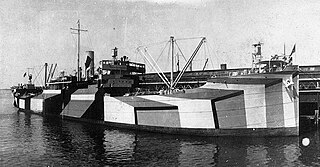
West Compo was a steam cargo ship built in 1918–1919 by Northwest Steel Company of Portland for the United States Shipping Board as part of the wartime shipbuilding program of the Emergency Fleet Corporation (EFC) to restore the nation's Merchant Marine. The vessel was commissioned into the Naval Overseas Transportation Service (NOTS) of the United States Navy in January 1919 and after only one overseas trip was decommissioned four months later and returned to the USSB. Afterwards the vessel was largely employed on the Atlantic Coast of the United States to France route until mid-1921 when she was laid up and eventually broken up for scrap in 1936.
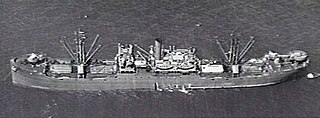
USS West Corum (ID-3982) was a cargo ship for the United States Navy in 1919. The ship was built as SS West Corum and reverted to that name at the end of her Navy service. During World War II, the ship was United States Army transport ship USAT West Corum, later renamed to Will H. Point.
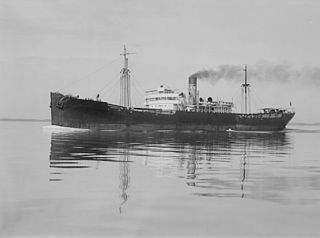
SS West Elcajon was a steel-hulled cargo ship built in 1918 for the United States Shipping Board's World War I emergency wartime shipbuilding program.

SS West Hosokie was a steel–hulled cargo ship built in 1918 as part of the World War I emergency wartime shipbuilding program organized by the United States Shipping Board.

SS West Gotomska was a steel–hulled cargo ship built in 1918 as part of the World War I emergency wartime shipbuilding program organized by the United States Shipping Board.

SS Edenton was a steel-hulled cargo ship built in 1918 for the United States Shipping Board as part of the Board's World War I emergency shipbuilding program.
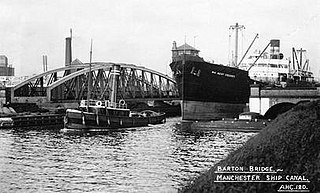
SS West Cressey was a steel-hulled cargo ship that saw a brief period of service as an auxiliary with the U.S. Navy in the aftermath of World War I.

SS West Loquassuck was a steel–hulled cargo ship built for the United States Shipping Board's Emergency Fleet Corporation in World War I. After completion on 15 October 1918, the ship was immediately commissioned into the U.S. Navy as USS West Loquassuck (ID-3638), just weeks before the end of the war.

SS West Mahomet was a steel–hulled cargo ship which saw service as an auxiliary with the U.S. Navy in 1918-19.
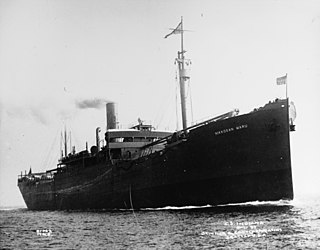
USS Western Front (ID-1787) was a steel-hulled cargo ship which saw service as an auxiliary with the United States Navy in World War I. Initially named Martha Washington, she was laid down for mercantile service as Nikkosan Maru, but following America's entry into the war, was requisitioned by the United States Shipping Board and commissioned into the U.S. Navy as the supply ship USS Indiana. This name was also quickly dropped however, in favour of USS Western Front.

SS West Eldara was a steel-hulled cargo ship built in 1918 as part of the United States Shipping Board's emergency World War I shipbuilding program.

USS West Hobomac was a steel–hulled cargo ship which saw service with the U.S. Navy as an auxiliary during World War I, and which later operated under the British flag during World War II before being lost to enemy action.

SS West Humhaw was a steel–hulled cargo ship built in 1918 as part of the United States Shipping Board's emergency World War I shipbuilding program.
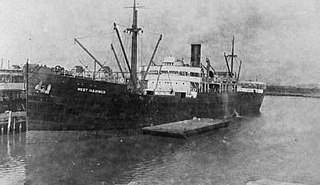
SS West Maximus was a steel-hulled freighter built for the United States Shipping Board's emergency wartime construction program during World War I. Completed too late to see service in the war, West Maximus spent the interwar years in commercial service.
The Skinner & Eddy Corporation, commonly known as Skinner & Eddy, was a Seattle, Washington-based shipbuilding corporation that existed from 1916 to 1923. The yard is notable for completing more ships for the United States war effort during World War I than any other West Coast shipyard, and also for breaking world production speed records for individual ship construction.
Portmar was a United States-flagged merchant vessel that was constructed in response to World War I, operated by a succession of companies in the interwar period, then taken up for wartime shipping in World War II.

SS Bulgaria was a passenger-cargo steamship built in 1898 for the Hamburg American Line ("Hapag"). During World War I, she operated as a United States Army animal and cargo ship under the names USAT Hercules and USAT Philippines, and after the war was converted into the troop transport USS Philippines (ID-1677).
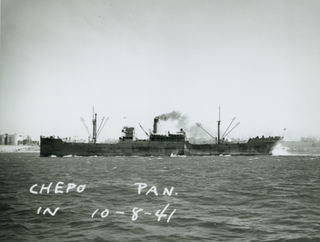
West Pocasset was a steam cargo ship built in 1919 by Northwest Steel Company of Portland for the United States Shipping Board as part of the wartime shipbuilding program of the Emergency Fleet Corporation (EFC) to restore the nation's Merchant Marine. The freighter was operated sparingly on the United States to Europe routes during the first two years of her career before being laid up. The ship was briefly reactivated in 1929 but was again laid up next year and remained idle for the next ten years. In January 1941 the freighter was sold together with four other vessels to the United States Line and was put under operation by its fully owned Panama-registered subsidiary to carry war matériel and supplies between Canada and United Kingdom and renamed Chepo. In early January 1942 while on one of her regular convoy trips, she was torpedoed and sunk by German submarine U-43 with the loss of seventeen men.



















